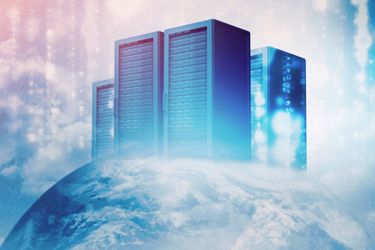The Data Center Water Challenge: How Atmospheric Water Harvesting Can Secure AI's Thirsty Future
By Magnus Bach

Artificial Intelligence (AI) is in a phase of exponential growth. Much of this growth will be powered by machine learning, natural language processing, and robotics. These applications require hyperscale and colocation data centers to support their massive computational loads. Yet behind this growth lies a critical and often overlooked consequence: a rapidly rising demand for water.
Data Centers Are Booming, But Where Does The Water Come From?
Data centers are not only energy-intensive but also water-intensive. To keep servers cool and maintain uninterrupted operation, vast amounts of water are consumed in cooling systems every day. As computational loads increase with the growth of AI, this hidden water footprint is expanding rapidly, placing additional strain on local supplies that are often already under pressure.
Nowhere is this tension more visible than in the Western and Southwestern United States. These regions are magnets for data center growth because of their robust infrastructure and proximity to metropolitan and tech hubs. Yet, they are also among the most drought-prone areas in the country.
Despite hosting only about 20% of U.S. servers, the Western and Southwestern U.S. accounts for roughly 70% of the data-center industry’s water-scarcity footprint. The imbalance is striking. The same regions that are critical to powering AI’s future are simultaneously the ones least able to sustain its water demands.
The scale of the challenge is dramatic. U.S. data centers consumed 21.2 billion liters of water in 2013. By 2023, that figure had tripled to 66 billion liters. Today, hyperscale and colocation facilities, already responsible for 84% of this consumption, are set to expand further as AI adoption deepens.
Traditional strategies such as improving Water Usage Effectiveness (WUE) are valuable, but they are not enough. What matters most is reducing reliance on scarce local water resources. Without a paradigm shift, the digital economy risks colliding with the harsh realities of climate change and water scarcity.
What If We Could Efficiently Pull Water Out Of The Air?
A new generation of atmospheric water harvesting (AWH) solutions is prone to play a significant role in making next-gen data centers more sustainable and make them independent from scarce water sources. Unlike conventional cooling-condensation atmospheric water generators (AWGs), these advanced AWH solutions are based on nano-engineered reticular materials, with properties so novel that its inventor — and Atoco’s founder — Nobel Laureate Prof. Omar Yaghi was awarded the Nobel Prize in chemistry in 2025. The materials, often referred to as “MOFs” or “metal organic frameworks,” are highly porous crystalline frameworks with an internal surface area of up to several football fields per gram. They can be designed at the molecular level to capture nothing but water molecules from the atmosphere, even at extremely low humidity levels, acting almost like a molecular sponge, allowing them to “trap” water molecules in the pores.
By extracting water directly from air, advanced AWH solutions offer a way to decouple data center cooling from traditional water supplies. These systems can generate pure, contaminant-free water from the atmosphere that can supply cooling processes or be recirculated into the system. By combining generation and recapture, the technology significantly reduces, and potentially neutralizes, the net water consumption of a data center, thereby unlocking costly permitting gridlocks that many datacenter developers now face in areas prone to waterstress or shortages.
Sustainability Meets Resilience
The benefits extend beyond sustainability. Data centers generate significant heat from the constant operation of servers and other equipment which require efficient cooling systems to maintain optimal operating temperature. This heat is typically of relatively low temperature, making it difficult to utilize. Advanced AWH solutions, however, can utilize this low-grade waste heat to power the water generation process, thus entirely offsetting any power consumption linked to the harvesting of water from air. Naturally, this lowers the operating costs of the datacenter.
Another very interesting economical upside linked to such a setup is that advanced AWH solutions “eat heat” in the process of generating water from air, thereby reducing the temperature of the hot stream cooling water, before returning it to the cooling tower. Such temperature reductions not only reduce the overall loads on the cooling system of the data center, but also the costly energy consumption derived from it. In a nutshell, such a dual proposition offers an opportunity to transform low-grade waste heat into a valuable resource, pure water, which can be used for multiple purposes, such as make-up water for cooling towers, potable water for employees, or to replenish communities. In effect, AWH becomes a “free energy” water solution that not only shrinks a data center’s carbon footprint but also strengthens its operational resilience. Because the water is harvested directly from the self-replenishing atmosphere, the supply is entirely decentralized and independent of municipal networks or aquifers. This means that data centers can secure their own sustainable source of ultra-pure water without depleting already scarce regional resources.
In regions vulnerable to hurricanes, wildfires, or grid disruptions, this independent, stable, off-grid water supply is especially valuable. Such reliability is an essential safeguard for mission-critical facilities that cannot afford interruptions, and it provides a blueprint for how digital infrastructure can grow without compromising the natural water balance of the communities around it.
Why Water Independence Matters For AI’s Future
For AI to flourish sustainably, its foundational infrastructure must be decoupled from vulnerable natural resources. Going forward, data centers need to ensure not only sustainable, yet reliable electricity supply but also sustainable, yet reliable water supply. AWH technology based on nano-engineered reticular materials makes this possible by offering:
- Water security: increased independence from strained municipal supplies.
- Pure water: reducing maintenance costs and equipment risk.
- Climate resilience: ensuring uptime during environmental crises.
The AI revolution cannot be built on a foundation of water scarcity. As data centers continue to scale at hyperspeed and water scarcity worsens, advanced atmospheric water harvesting provides a transformative pathway to align digital growth with ecological responsibility.
Water industry leaders, policymakers, and technology providers must collaborate now to accelerate adoption of these solutions. If we succeed, we will not only secure the future of AI but also chart a blueprint for resilient, sustainable infrastructure in a warming world.
 Magnus Bach is VP of Business Development for Atoco.
Magnus Bach is VP of Business Development for Atoco.
